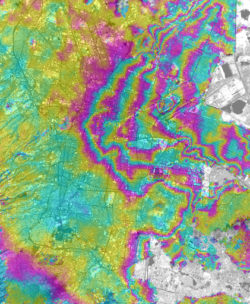Reservoir characterization using passive surface seismic data

Project lead: Professor Sebastian Rost
Project objectives
- Characterizing seismic codas (P- and S-waves) for a geothermal reservoir before, during and after stimulation
- Developing the MLTWA for application to surface seismic data from a geothermal reservoir and comparison with synthetic waveforms through fractured media
- Comparison of scattered surface seismic data with borehole data
Summary of the project
Seismic imaging is a main tool in the exploration of geothermal reservoirs to understand reservoir structure and fluid pathways. Commonly employed imaging techniques, such as reflection seismics and traveltime tomography are limited in their resolution of reservoir structure due to the seismic wavelength. Especially the important fracture distribution within the reservoir cannot be fully characterized. Limited monitoring of the geothermal reservoir can be achieved using microseismicity and potentially 4D controlled source experiments during stimulation and production. But the related costs are prohibitive in many localities.
Here we propose to use the seismic coda that is generated by scattering of the seismic wavefield at structures with scalelengths below the seismic wavelength. Seismic scattering is an underutilized part of the seismic wavefield and had very limited application in the imaging and monitoring of geothermal sites. Here we aim to develop a cost-effective approach for reservoir characterization using passive surface seismic data.
The seismic wavefield is sensitive to the elastic parameters of the material. Most seismic imaging techniques can only image structures that are larger than the seismic wavelength. On the other hand, the structures that are essential in the assessment of geothermal reservoirs, mainly fractures, have scale-lengths that are much smaller. These smaller-scale structures can be constrained and imaged using the scattered seismic wavefield. This project goes beyond the standard reflection seismic imaging of major fault zones and fractures by aiming for better constraining fracture density using passive seismic data.
We will use data from the FORGE project (Pankow et al., 2020) in Utah (US) which is well instrumented with surface broadband stations, borehole geophones, a nodal network and surface geophone arrays as well as situated within a dense regional seismic network. Using the codas of both induced seismicity and local and regional seismicity we will employ the Multi-lapse Time Window Analysis (MLTWA) (Hoshiba et al., 1991) allowing the separation of intrinsic and scattering quality factor Q. Both factors can be used to characterize the reservoir. The FORGE data allow characterization at different points of the reservoir lifecycle. We will test our approach with synthetic wavefield generated through fractured media and aim to quantitatively characterize the medium. While borehole instruments have been used to determine scattering heterogeneities the application to surface seismic instruments is novel. Using passive surface seismics will establish a more cost-effective approach to characterizing the reservoir. The project will be supervised by Sebastian Rost (scattering, array seismology), Andy Nowacki (seismology, microseismicity), and Mark Hildyard (synthetic seismograms). The project is well suited for a 1 year Masters by Research and data and preliminary data analysis techniques are available.
References:
Hoshiba M., H. Sato, M. Fehler (1991), Numerical Basis of the Separation of Scattering and Intrinsic Absorption from Full Seismogram Envelope, Papers in
Meteorology and Geophysics, Volume 42, Issue 2, Pages 65-91.
Pankow K., M. Mesimeri, J. McLennan, P. Wannamaker, and J. Moore (2020), Seismic Monitoring at the Utah Frontier Observatory for Research in Geothermal
Energy, Proceedings, 45th Workshop on Geothermal Reservoir Engineering
Project outcomes
This project will establish the potential of characterizing geothermal reservoirs through seismic scattering potential. While borehole instruments with controlled sources have been used in research settings, the application to passive surface seismic data will allow a cost-effective application of the methodology. We will explore if microseismic events are suitable for this approach and will extend the approach through application to local and regional events allowing reservoir characterization throughout the lifecycle. We will develop a suitable workflow for the processing that can be shared with stakeholders.
